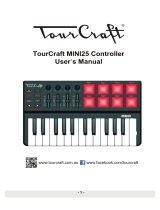
E 2
Table of contents
Introduction ...........................................2
minilogue Key Features .................................. 2
Block Diagram .................................................... 3
Controls and Connections ....................4
Front Panel Controls ........................................ 4
Rear Panel Connections .................................. 5
Turning the minilogue On and O ............. 6
Playing Programs and Sequences ........8
Selecting and Playing a Program ................ 8
Using Favorites .................................................. 9
Playing the Sequencer ..................................10
Programs ............................................. 11
Program Architecture .................................... 11
Creating Sounds ..............................................12
Saving a Program ............................................13
Basic Parameter Editing ................................14
Voice modes .....................................................23
Sequencer .......................................................... 25
Edit Mode ............................................ 31
How to enter the Edit mode .......................31
PROGRAM EDIT mode ...................................33
SEQ EDIT mode ................................................37
GLOBAL EDIT mode ........................................40
Other functions ................................... 47
Tuning .................................................................47
Restoring the Factory settings ...................47
Shortcuts using the SHIFT button ............. 49
Understanding MIDI ........................... 50
Connecting Devices via MIDI and USB ....50
MIDI-Related Settings ....................................52
Program List ........................................ 54
Specications ...................................... 56
MIDI Implementation Chart ............... 57





















